Who Are the Different Actors in a Home Remodeling Project?

If you’ve never done a major remodel on your home before, you may be surprised to find just how many people it takes to make it happen, much like the lengthy credits at the end of a Hollywood movie (what in the world is a gaffer, anyway?).
If you’re heading into a remodel, it’s good to know the different ‘actors’ (to continue with the movie metaphor) or parties to the project so that you know who to expect to be responsible for what.
Meet the Cast
Starring…
The Homeowner
No surprises here, that’s you!
If the remodel actually were a movie production, you would be like the studio: you’re the money behind it, and you have the ultimate authority over everything that goes on, up to and including firing the ‘director’ if things don’t proceed to your liking.
You can be as hands-on as you choose and no one may tell you otherwise, or you may leave things in the hands of your team and check in on them periodically to monitor their progress and sign off on various decisions.


Your Lender
Technically, your home improvement loan lender is the money behind the project (unless you’re paying cash), but they’re like a silent partner–they don’t make any appearances ‘on the stage.’
They deliver you a lump sum payment that you may use on the project in virtually any way you see fit.
This party to the remodel may be a loan officer at a bank or credit union, a loan broker, an agent for an online lender, or even a peer-to-peer lender. It’s likely that you never even need to meet your lender in person, as many providers allow you to secure your loan online or over the phone.
The downside of course is that your ‘correspondence’ with your lender will last anywhere from one to 15 years, depending on the size of your loan and your repayment plan.
Your Insurance Company
This actor doesn’t make it onto the playbill in many remodel projects, but it really should.
Not only may a remodel affect the cost to rebuild your home or replace belongings, some home insurers require you to notify them of any additions or alterations and may even penalize you for failure to do so.


The Officials
On most remodels it’s necessary for us to obtain a General Contractor’s Building Permit, and our mechanical subcontractors pull their own permits.
So City Hall/the city or county building department is usually an actor in the project, although you shouldn’t have to deal with them directly.
But you may wish to seek your homeowner’s association’s approval yourself before hiring a general contractor just to get the ball rolling. The HOA will need to sign off on any exterior changes, and often some interior renovations such as rewiring, flooring, or structural work.
While it’s true that if you don’t notify them, they’ll likely never know if interior work is done, but they’ll almost certainly be aware of exterior changes, either by sending someone to check or receiving notice from one of your neighbors.
The General Contractor
Ideally, this is Legal Eagle Contractors!
But whichever company you hire to handle the work on your remodel–although you may meet initially with the owner of the general contractor (GC) firm–they should have two key players with whom you interact the most:
- The Project Manager: Whereas a general contractor is a company (unless it’s a one-person operation), the project manager is the individual person who’s in charge on the job site. He may work for the GC or he may be hired by you to come in and oversee the project, scheduling subcontractors, ordering materials, and more. He’s your point person on the project.
- The Selections Coordinator: This person is an invaluable resource for helping you make style, finish, and color selections during the remodel. She will serve as a go-between for vendors, connecting you with options for materials and appliances and advising you of the timelines for order deliveries and installations.


The Designer
If your GC isn’t a design-build firm like Legal Eagle, then you may (depending on the scope of the project) need another player to fill the role of project designer.
This could be a licensed architect or engineer under certain circumstances, such as remodeling a historic home or making major changes such as adding a room or story onto the house.
But in many cases a draftsperson or architectural designer could suffice to draw up plans for you at a much lower price point.
The Subcontractors
General contractors don’t do everything on a renovation themselves; they hire subcontractors to perform specific work such as roofing, masonry, flooring, HVAC, etc.
And while the project manager oversees their work, you may not see him everyday; but the subcontractors are the folks you’ll have coming and going each day to move the project along.
You should be able to discuss minor issues and questions with the subcontractors.
Some homeowners choose to provide cold drinks or snacks or even occasional meals for the subcontractors, and while you’re not obligated to do so, it never hurts to be on good terms with your supporting cast.
If, however, things take a turn for the worse and a dispute arises over their payment from the GC, it is possible for a subcontractor to place a lien on your home, even if you’ve paid the GC. I
t’s yet another reason choosing an honest remodeler is so important.
Use our contractor test to find a reputable home contractor.


The Vendors
There are countless sources out there for materials and services for home remodels, from big box stores to specialty retailers to flea markets.
This is why the Selections Coordinator is so helpful–she can help you narrow down the list of vendors based on a) your style and what kinds of items you’re looking for, b) companies we have relationships with and trust to deliver high quality, and c) the availability of specific pieces based on current market trends.
Often she can negotiate a better deal with one of our trusted dealers than you would be able to work on your own, as well.
How the Different Parties in a Home Remodel Interact
| Actor | Role | Answers to… | Paid by… | Amount of contact with homeowner | Phase(s) involved |
|---|---|---|---|---|---|
| Homeowner | Makes approvals, oversees Project Manager, cuts checks | – – – | – – – | – – – | All phases |
| Lender | Provides funding for the project | – – – | Homeowner | Minimal | Pre-construction |
| Insurance Company | Approves changes to home, modifies coverage (if necessary) | – – – | Homeowner | Minimal | Pre-construction |
| Officials | Approves modifications, issues permits | – – – | Homeowner (directly or through GC) | None – minimal | Pre-construction, post-construction |
| General Contractor/Project Manager | Oversees work, hires and pays subcontractors, pulls permits, and more | Homeowner, officials | Homeowner (GC) or GC (Project Manager) | Constant | All phases |
| Selections Coordinator | Helps with style, finish, and color selections, assists homeowner in working with vendors | Homeowner, GC | GC | Moderate | Pre-construction, construction |
| Vendors | Provides materials and services | Homeowner, GC, Selections Coordinator | Homeowner (directly or through GC) | Moderate | Pre-construction, construction |
| Designer (if necessary) | Creates plans/blueprints for the project | Homeowner | Homeowner | Moderate | Pre-construction |
| Subcontractors | Performs variety of construction work | GC, Homeowner | GC | Minimal | Construction |
Visualizing the Relationships







